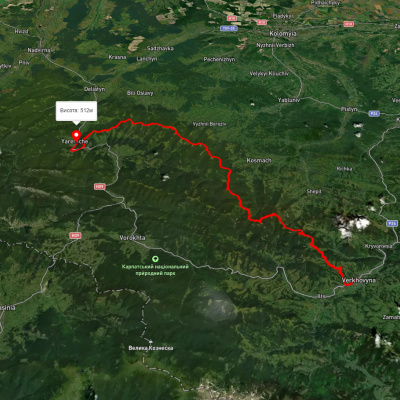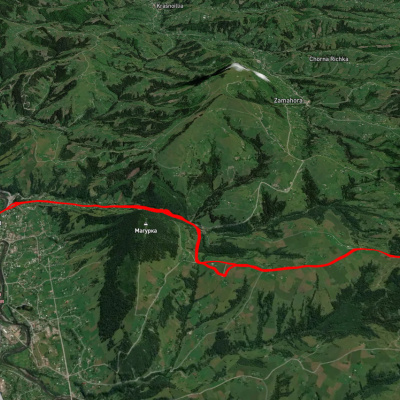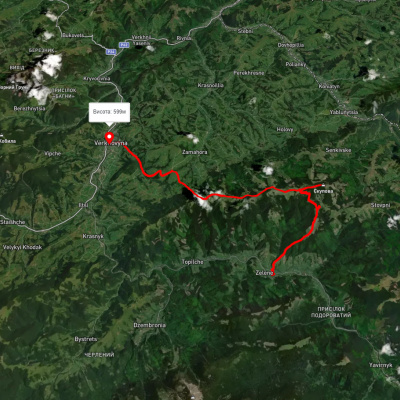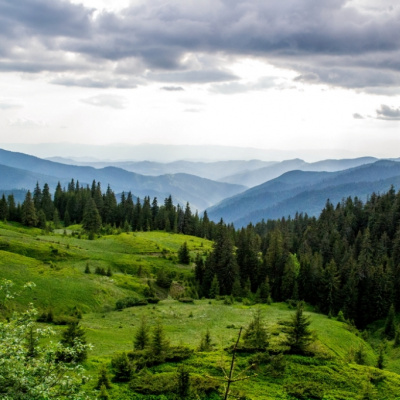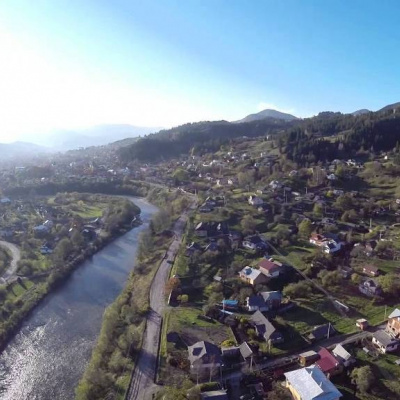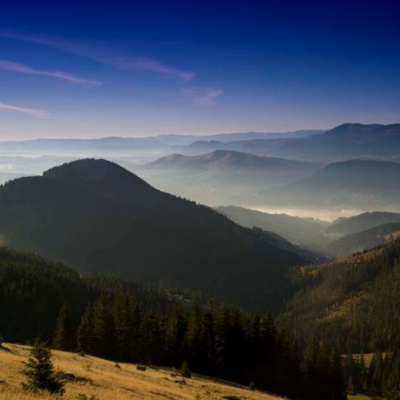Verkhovyna
The Verkhovyna is characterized by colorful valleys, breathtaking mountain peaks, streams with clean, clear water, and clean mountain air. Verkhovyna is called the center of Hutsul culture.
Verkhovyna (until 1962 - the village of Zhabie, Polish: Żabie) is an urban-type settlement in Ivano-Frankivsk region, the administrative center of Verkhovyna district and Verkhovyna district council. It is located at an altitude of 620 m above sea level, on the banks of the Black Cheremosh River, 120 km from Ivano-Frankivsk and 30 km from the Vorokhta railway station.
Verkhovyna is a region rich in spruce forests, traditions and talented people. Thanks to a large number of museums, you can see with your own eyes how the Hutsuls lived in ancient times, what they ate and what they did. The mysterious Pysanyi Kamen, Pip Ivan, and Lake Maricheika await tourism enthusiasts. And starting from the village of Verkhovyna, the Black Cheremosh will accompany the traveler.
The Hutsuls call Cheremosh a faithful son of the Carpathians, who, born in the mountains, lives here and dies here, flowing into the Prut. You can come here not only for the beautiful scenery and the steep trail to the two-thousand-foot mountain, but also for the local stories: about Dovbush's treasures hidden somewhere deep in the mountains, about the girl Marichka who saved the village from the enemies, about ancient sanctuaries and gods worshipped, about traditions both current and forgotten ...
And the Pysanyi Kamen is one of the most mysterious places in Verkhovyna, located at an altitude of about 1000 meters above sea level. The complex of rocks ranging in height from 2 to 20 meters contains rock images, the oldest of which date back to the times of Kievan Rus. According to some legends, there was a pagan temple here: nine round stone hollows have been preserved to this day. Discover the wonderful world of the Carpathians - visit Verkhovyna!
The peaks surrounding Verkhovyna:
- White Mare I (1476.9 m)
- White Mare II (1424.8 m)
- Synitsy (1185.5 m)
- Magura (1116.0 m),
- Magurka (1024.1 m)
- Pidmagura (1063.4 m)
- Vipche (1374.8 m)
- Vypchenka (1368.5 m)
- Hrybkova (1237.7 m)
- Pushkar (809 m).
- Plai.
The village of Verkhovyna was called Zhabie until 1962. The first written mention of the village of Zhabie dates back to 1424, when it, along with the monastery on the Rybnytsia River (present-day Kosiv), was given by the Lithuanian prince Svidrigailo as a gift to the local wealthy man Vlad Dragosymovych. There is a legend that the first settler in the Black Cheremosh valley was Zhabka, from whom the former Zhabie was named. According to another version, there were many frogs in the swampy river valley, hence the name of the settlement.
In April 1920, a peasant uprising took place in Zhab'yem, which was suppressed by the Polish authorities. From 1921 to 1939 Verkhovyna was part of Poland. In 1772, the first partition of Poland took place between Russia, Prussia, and Austria. As a result of this event, the lands of today's Verkhovyna district became part of the Austrian Empire.
In the eighteenth and early nineteenth centuries, the movement of opryshky, or "people's avengers," who fought against feudal and serfdom oppression by the Polish and Ukrainian nobility, Moldavian feudal lords, and Austrian and Hungarian landowners, became increasingly popular in Verkhovyna (then the village of Zhabiemu). Material inequality, national oppression, and increased exploitation of the population of mountainous areas prompted the inhabitants of Zhabiyo village to join the units of Oleksa Dovbush, Pintya, Boychuk, and Boyuvak. In the first half of the nineteenth century, opryshky units led by M. Shtoliuk operated in Zhab'yo and neighboring villages. Vichas, a new form of the liberation movement of the late nineteenth century, became a mass phenomenon among the inhabitants of mountainous areas.
In 1962, the village of Zhabie was renamed Verkhovyna. Verkhovyna in the Carpathians is the most elevated part of the terrain. This name of the village is fully justified. Even its lower part is located at an altitude of 620 m above sea level, and most of it, which is mostly in the mountains, is much higher. For example, the highest mountain road in Verkhovyna is located on a high pass at an altitude of 1250 meters. This makes Verkhovyna one of the highest mountain settlements in Ukraine.
Attractions and museums
- Historical and Local Lore Museum "Hutsulshchyna" - I. Franko Street
- House-museum of the movie "Shadows of Forgotten Ancestors" - Zhabievsky Potik Street
- Verkhovyna Museum of Musical Instruments by Roman Kumlyk
- Verkhovyna Museum of Folk Culture "At the Trembitard", pr. Shveykovo
- Annichka Citizen House Museum, 56 Zhabievsky Potik St.
- Museum of Hutsul Magic, Zhabievsky Potik Street
- Vyshyvanka Museum, Velykyi Hrabovets village
- Hata Staya (cheese factory), Zhabievsky Potik Street
- Museum of Paraska Plytka-Horytsvit, Kryvorivnia village, Grashparivka village
- Museum of Applied Arts, Iltsi village
Individual excursions and tours to monuments, museums and mountains of Verkhovyna region
- Sightseeing tour of Verkhovyna with a visit to one of the museums and an observation tower;
- Excursion to the S. Parajanov Museum "Shadows of Forgotten Ancestors";
- Excursion to the Roman Kumlyk Museum of Musical Instruments, Verkhovyna;
- Museum of Hutsul Magic in Verkhovyna;
- Halyna Verkhovynka's private museum "Vyshyvanka", Iltsi village;
- Excursion to the Museum of Hutsul Life and Art "At the Trembitard", Verkhovyna (Shveykovo village);
- Excursion to the Mykhailo Hrushevsky Museum in Kryvorivnia;
- Excursion to the Ivan Franko Museum in Kryvorivnya;
- Excursion to the House-Citizen Museum in Kryvorivnia;
- Ethnographic Museum of Hutsul Antiquities - Yaroslav Zelenchuk's private museum, Kryvorivnia village;
- Private museum Gallery of Hutsul traditions and rituals, Verkhovyna;
- One-day hikes on the Chornohora ridge: to Mt. Vuhatyi Kamen, Rebra and Shpytsi mountains;
- One-day hikes to Pushkar, Magurka, Magura, Plai, Bila Kobyla;
- Excursion to the Krynta meadow.
Mountain Search and Rescue Service, phone: (096) 372 44 00, (067) 882 28 00.
Tourist Information Center, Verkhovyna village, 7 M. Rybchuk str. +38 (03432) 2-19-41, 2-19-71, +38 (096) 372-44-00, +38 (067) 88-22-800.
Які туристичні (пішохідні) маршрути проходять через/біля Verkhovyna?
Пропонуємо пройти такі туристичні (пішохідні) маршрути через/біля Verkhovyna: смт. Верховина, через г. Біла Кобила, г. Маковиця, Скелі Довбуша до м. Яремче, смт. Верховина – хр. Кринта-Скупова – смт. Верховина, с. Зелене, через г. Скупова до смт. Верховина, смт. Верховина – хр. Кринта-Скупова, смт. Верховина – г. Скупова, смт. Верховина, через г. Біла Кобила, г. Хорде до с. Татарів
